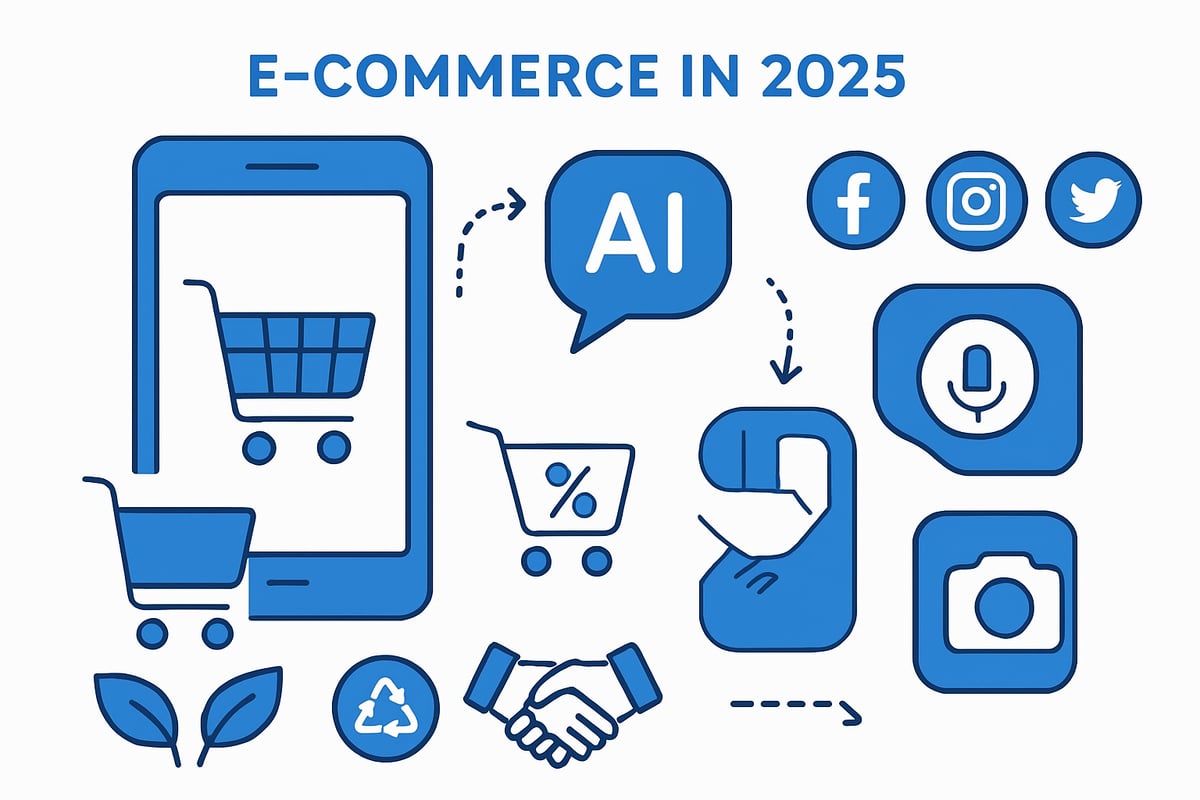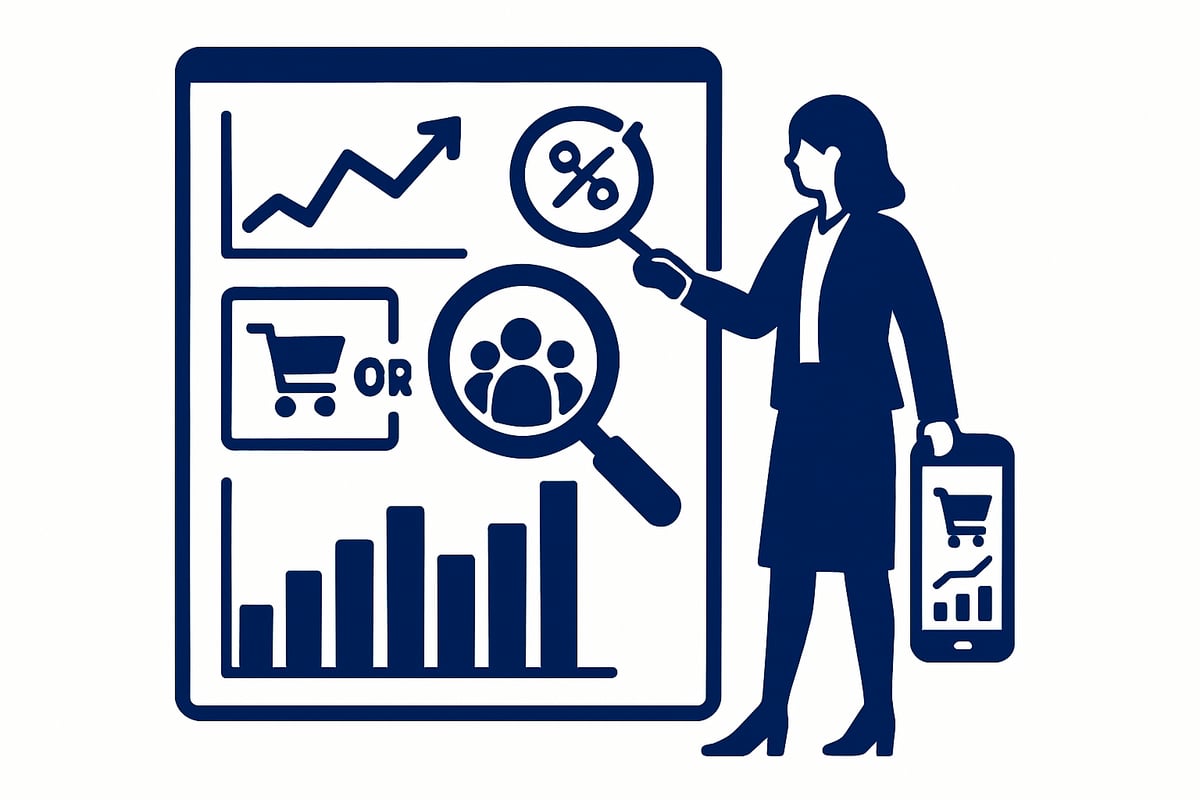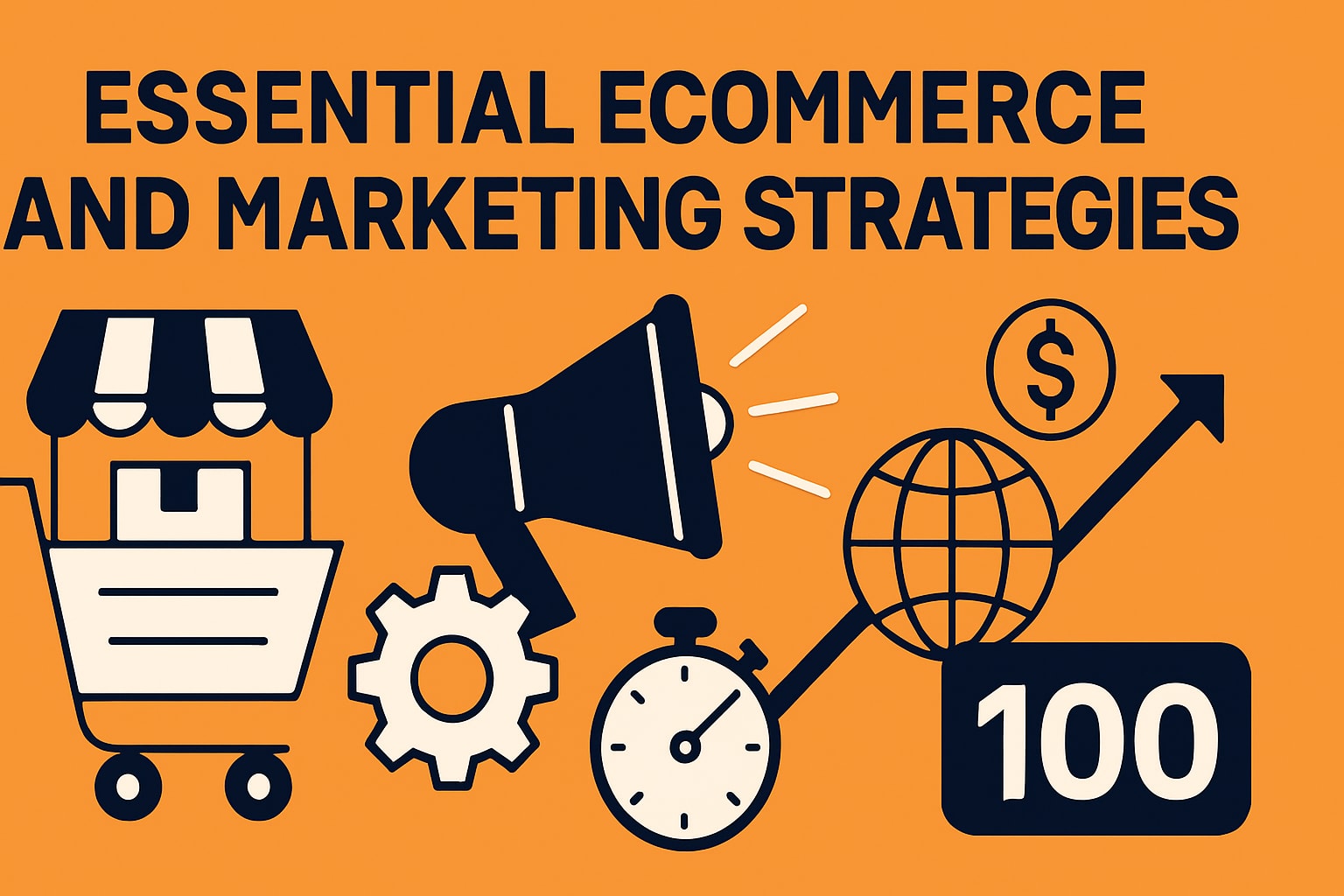The world of ecommerce is changing faster than ever, and what helped you win last year might not even move the needle today. If you want your business to stand out in 2025, you need to rethink your approach and embrace new ecommerce and marketing strategies.
This guide is here to help you do exactly that. We will walk through the 7 most important ecommerce and marketing strategies that every ambitious brand should use to stay ahead. Are you ready to future-proof your store, attract modern shoppers, and build long-term growth?
From AI-powered personalization to seamless omnichannel experiences, you will discover actionable tactics designed to boost your visibility, conversions, and customer loyalty. The landscape is shifting—let’s make sure you’re leading the way.
The Shifting Ecommerce Landscape in 2025
The world of ecommerce is moving fast, and 2025 is set to bring even more changes. If you want to succeed, you need to understand the forces at play. Let’s break down the key shifts shaping the future of ecommerce and marketing strategies, so you can adapt and thrive.

Major Trends Shaping Ecommerce
What are the big trends rewriting the rules for ecommerce and marketing strategies in 2025? First, mobile commerce is exploding. Shoppers expect to browse and buy on their phones, anytime and anywhere. Social shopping is also booming, with platforms like Instagram and TikTok doubling as storefronts.
AI, automation, and data-driven decisions are now at the heart of every successful brand. Personalization is a must, not a bonus. Voice search and visual commerce are influencing what people buy and how they find it. Shoppers also want brands to care about the planet. Sustainability and ethical practices aren’t optional anymore, they’re key differentiators.
Want more expert perspectives? Check out these Ecommerce marketing expert insights to see how industry leaders are adapting their ecommerce and marketing strategies for the future.
Evolving Customer Expectations
Customer expectations have evolved just as quickly. People want lightning-fast, frictionless checkout and real-time support. If your checkout process is clunky, you risk losing them.
Personalization is huge. Shoppers expect product recommendations and content tailored to their tastes. They trust user-generated content, reviews, and social proof more than ever, so showcasing real customer voices is essential.
Transparency and shared values matter. Today’s buyers prefer brands that align with their beliefs and are open about their practices. Meeting these expectations should be at the core of your ecommerce and marketing strategies.
The Role of Technology and Data
Technology and data are the engines behind next-level ecommerce and marketing strategies. AI and machine learning help brands segment customers, target campaigns, and automate personalized experiences.
Advanced analytics give predictive insights and enable dynamic pricing. Augmented reality and virtual reality are creating immersive product experiences, letting shoppers “try before they buy” from home.
Data privacy and compliance are non-negotiable. Customers want to know their information is safe, so prioritizing security is a must for building trust in your ecommerce and marketing strategies.
| Technology | Impact on Ecommerce 2025 |
|---|---|
| AI/Machine Learning | Smarter targeting and automation |
| Advanced Analytics | Predictive insights and pricing |
| AR/VR | Immersive product experiences |
| Data Privacy | Essential for customer trust |
Competitive Pressures and Opportunity
Competition is fierce, but barriers to entry have never been lower. Brands that innovate and adapt their ecommerce and marketing strategies quickly will stand out.
If you’re ready to move fast and embrace change, you’ll find opportunities where others see obstacles.
7 Essential Ecommerce and Marketing Strategies for 2025 Success
Ready to future-proof your business? Let’s dive into the 7 essential ecommerce and marketing strategies that will help you not only survive but thrive in 2025. Whether you’re a seasoned pro or just getting started, these tactics will give you the clarity and confidence you need to stand out. Keep an eye out for practical examples and stats that show why each approach matters.

1. AI-Driven Personalization Across the Customer Journey
AI is no longer a buzzword. It’s the backbone of ecommerce and marketing strategies that win in 2025. You can use machine learning to deliver personalized product recommendations, dynamic offers, and content that feels handpicked for each visitor.
By tracking behavioral data, brands segment audiences and trigger automated, relevant messaging across email, SMS, and web. Imagine landing on a site and seeing content that morphs to your tastes in real time. Some brands even use AI-powered quizzes that guide shoppers to their perfect product match.
According to Salesforce, 71% of consumers now expect personalized interactions. When you deliver on that, you see higher conversion rates, bigger average orders, and stronger loyalty. To learn more about how AI is shaping personalization, check out this AI-driven personalization in marketing overview.
Want to keep your customers coming back? Make personalization the heart of your ecommerce and marketing strategies.
2. Omnichannel Engagement and Consistent Brand Experience
Today’s shoppers switch between devices and platforms in a blink. Your ecommerce and marketing strategies must keep up by blending online and offline touchpoints into one seamless experience.
Start by integrating your website, social media, marketplaces, and, if you have them, brick-and-mortar stores. Consistent messaging and visuals across all channels build trust and recognition. Use customer data to retarget shoppers who browse on one platform and buy on another.
Brands that connect TikTok, Instagram, Google Shopping, and physical locations create a unified journey. Stats show companies with strong omnichannel strategies retain 89% of their customers. The payoff? You maximize reach, boost retention, and build long-term brand trust.
The key to success is simple: meet customers where they are and keep your presence cohesive. This approach should be at the core of your ecommerce and marketing strategies.
3. Optimizing for Mobile-First and Voice Commerce
Mobile shopping is the norm, not the exception. If your ecommerce and marketing strategies aren’t mobile-first, you’re missing out on over half of your potential traffic.
Design your site to be responsive, fast, and easy to navigate. Simplify checkout with mobile wallets and one-tap payments. But don’t stop there. Voice search is on the rise, changing how consumers find and buy products. Optimize your content for natural, conversational keywords people use when speaking to smart assistants.
Forward-thinking brands are launching voice-enabled shopping assistants and chatbots. Statista reports nearly 60% of global website traffic comes from mobile devices. Want to dig deeper? See this voice search optimization in ecommerce resource for actionable tips.
If you want to capture on-the-go shoppers and boost mobile conversions, make mobile and voice optimization a top priority in your ecommerce and marketing strategies.
4. Leveraging User-Generated Content and Social Proof
People trust people, not ads. That’s why user-generated content (UGC) is a game-changer for ecommerce and marketing strategies in 2025.
Encourage your customers to share reviews, photos, and videos of your products. Feature this content on your product pages, ads, and social feeds. Run contests or partner with influencers to spark authentic UGC.
Brands that highlight real customer stories and influencer collaborations see increased engagement and conversions. In fact, 78% of US shoppers discover new products via social media. Want to understand the power of UGC? This User-generated content's role in marketing article breaks down its impact.
Social proof builds trust and helps your ecommerce and marketing strategies cut through skepticism, turning browsers into buyers.
5. Advanced Email and Onsite Marketing Automation
Automation is your secret weapon for scaling ecommerce and marketing strategies without losing the personal touch. Use popups, notification feeds, and landing pages to grab attention and collect leads.
Set up behavior-triggered email sequences, like abandoned cart reminders or post-purchase thank yous. Segment your lists so every customer gets offers tailored to their interests. For example, some stores use onsite popups to convert over 5% of visitors.
Email marketing, when automated and personalized, delivers an average ROI of $42 for every $1 spent. This isn’t just about saving time. It’s about nurturing leads, boosting retention, and maximizing lifetime value as part of your ecommerce and marketing strategies.
6. Data-Driven SEO and Content Marketing
Great ecommerce and marketing strategies start with visibility. Use keyword research to target high-intent, product-focused searches. Optimize your product pages for search engines using structured data and rich snippets.
Content is your magnet. Create guides, how-tos, and case studies that educate and attract your ideal shoppers. Regular SEO audits and technical optimization help you outrank competitors and keep your site healthy.
Google Shopping ads now account for 76% of ecommerce search ad spend, showing the importance of search visibility. For a step-by-step approach, check out this Ecommerce content strategy guide packed with actionable tips.
With strong analytics, you can monitor what works, refine your approach, and make your ecommerce and marketing strategies more effective over time.
7. Building Loyalty Through Retention and Community
Acquiring new customers is tough, but keeping them is where ecommerce and marketing strategies really pay off. Launch loyalty programs with rewards, exclusive perks, and early product access.
Build a vibrant brand community using social groups, forums, or events. Post-purchase follow-ups help you gather feedback and encourage repeat shopping. Brands that share customer stories and celebrate their fans turn buyers into advocates.
Companies focused on retention see up to 60% higher profitability. The benefits are clear: lower churn, higher lifetime value, and more referrals. Make loyalty and community-building central to your ecommerce and marketing strategies if you want to grow sustainably.
Measuring Success: KPIs and Analytics for Ecommerce Growth
How do you know if your ecommerce and marketing strategies are truly paying off? Measuring the right metrics is your first step toward smarter growth. Let’s break down how you can track progress, refine your approach, and make sure your efforts lead to real results.

Setting the Right Metrics
Choosing the right metrics is like setting your GPS before a road trip. You want to know exactly where you’re headed with your ecommerce and marketing strategies. Start by tracking these key performance indicators:
- Conversion Rate: Measures how many visitors become customers.
- Average Order Value (AOV): Tells you how much customers spend per transaction.
- Customer Acquisition Cost (CAC): Shows how much it costs to gain a new customer.
- Retention Rate: Reveals how many buyers keep coming back.
- Lifetime Value (LTV): Predicts the total value a customer brings over time.
Dive deeper by using cohort analysis to spot trends in customer behavior. Channel attribution helps you see which marketing sources drive the most value. Don’t forget A/B testing—experiment with different website elements or campaigns to find what works best for your ecommerce and marketing strategies.
Leveraging Analytics Tools and Insights
Once you know what to measure, the next step is using the right tools to make sense of your data. Platforms like Google Analytics, Shopify Analytics, and heatmap tools give you a real-time look at sales, traffic, and engagement. Setting up custom dashboards makes it easy to track your ecommerce and marketing strategies at a glance.
Want to predict what comes next? Use predictive analytics to forecast sales trends and manage inventory more effectively. The insights you gain allow you to iterate quickly and keep improving. For even more ideas on tracking and enhancing your content performance, check out these ecommerce content marketing tips.
Here’s a quick summary:
| KPI/Tool | What It Does |
|---|---|
| Conversion Rate | Measures visitor-to-customer success |
| AOV | Tracks average spend per order |
| CAC | Calculates cost to gain each customer |
| Retention Rate | Monitors repeat customer activity |
| Lifetime Value (LTV) | Predicts total revenue per customer |
| Analytics Platforms | Provide actionable business insights |
By staying focused on these analytics, you’ll ensure your ecommerce and marketing strategies are always moving your business forward.
So, after looking at these strategies, you might be wondering—how do you actually put all this into action without feeling overwhelmed by the constant changes in ecommerce? That’s where Nordhub comes in. Imagine having an AI-powered sidekick that not only tells you what to post and when to engage, but also helps you turn your social followers into real buyers. If you’re ready to stop chasing trends and actually get ahead of the curve for 2025, why not be one of the first to see what Nordhub can do? Get Early Access







.svg)
